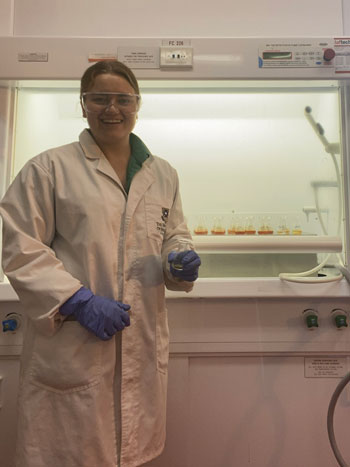Key points
- A radioactive tag is helping to trace phosphorus fertiliser
- Research is already showing that agronomic practices affect fertiliser use efficiency
- Preliminary results show deep-placed phosphorus is more likely to be utilised by a crop
Phosphorus fertiliser placement has a big effect on crop uptake, with new research quantifying its efficiency.
In her nearly completed PhD work, the University of Queensland’s Megan Hunter has found that deep-placed phosphorus is more likely to be used by a crop than shallow-placed phosphorus.
Based at the University of Queensland in Gatton, Ms Hunter has been working with Professor Mike Bell and Dr Tim McLaren on directly quantifying phosphorus fertiliser use efficiency.
Her preliminary results also show that nitrogen fertility matters. “If your soils have ample nitrogen, they will take up more phosphorus,” she says.
Although previous research has suggested that deep-placed phosphorus increases fertiliser use efficiency, for the first time her work highlights where the added phosphorus fertiliser goes.
This is due to new radioactive isotope work being undertaken at the University of Queensland, led by Dr McLaren.
His GRDC-invested project aims to quantify how much phosphorus fertiliser is used in vertosol soils across the northern region.
“There is a portion that reacts with the soil and is not taken up by the plant. There is also a portion that is lost to the environment. And then there is a portion that’s taken up by the crop,” Dr McLaren says.
This last portion can be difficult to evaluate. “And we don’t necessarily know what agronomic strategies affect that,” he says.
Tracking inputs
Dr McLaren says isotope research can be a very powerful technique for tracking fertiliser uptake in by crops.
Isotopes are distinct nuclear species of the same chemical element, a little like family members. They may share the same atomic number (or surname) but differ in distinct ways. This subtle difference makes isotopes added to fertilisers easy to differentiate and trace.
Nitrogen, for example, has two stable isotopes: N-14 and N-15. More than 99.6 per cent of nitrogen in nature is N-14 and 0.4 per cent is N-15.
Dr McLaren says N-15 (the stable sibling of N-14) helps researchers track nitrogen in the soil-plant system. “Essentially, wecan buy enriched fertiliser, like urea, which has a higher percentage of N-15 in it. This higher percentage of N-15 in the fertiliser helps us track movement of fertiliser-derived nitrogen.”
 Megan Hunter doing laboratory work (digesting plant material for nutrient analysis). Photo: Megan Hunter
Megan Hunter doing laboratory work (digesting plant material for nutrient analysis). Photo: Megan Hunter
The same idea is behind phosphorus fertiliser efficiency work, but there is one major difference – there is no stable phosphorus isotope (all phosphorus in nature is the stable isotope P-31).
Without a stable sibling of P-31, Dr McLaren is using the radioactive isotope P-33. “There are obvious challenges because it is a radioactive isotope. But for us to track the fate of phosphorus, we need a phosphorus isotope that is different to P-31.”
Dr McLaren says there are ways to assess fertiliser phosphorus effectiveness using indirect methods, including comparing control plots versus fertiliser treatment plots. “But that doesn’t help show if extra crop growth comes from phosphorus uptake from the fertiliser or from the soil. We’ve got to use a radioactive isotope to distinguish fertiliser P from soil P sources.”
His team, which includes Professor Peter Kopittke, is adding a small amount of P-33 to different phosphorus fertilisers, either alone or sometimes with 15-N labelled products such as MAP. The isotope P-33 has a half-life and will be trackable for one growing season before losing its radioactivity.
By knowing the ratio of added P-33 to P-31, calculations on fertiliser use efficiency can be made. “If we measure P-33 in the crop, then we know it must have come from the P-33 labelled fertiliser. This calculation then allows us to also assess how much of the phosphorus in the crop comes from the soil.”
Dr McLaren says isotope work is not new and was more popular in the 1960s and 1970s.
Its use waned as research focus shifted to other techniques and elements. Plus, radioactivity adds additional skill and regulation requirements and expense. “One millilitre of P-33 can cost tens of thousands of dollars. It has to be ordered specially and used carefully.”
However, early results from Ms Hunter show its worth. “Growers are buying and applying fertiliser because they want the crop to use more of it. If we can get a better insight into where added phosphorus goes, then we can also work out which agronomic strategies make better use of it and provide a better return on investment.”
The four-year project will focus on field-based experiments, with supporting information coming from glasshouse and laboratory-based experiments.
More information: Tim McLaren, 07 3365 2128, [email protected]; Megan Hunter, [email protected]

























































